Rosetta PDS, Images and other products made from archived data |

  |
Rosetta PDS, Images and other products made from archived data |
 Dec 16 2015, 04:29 PM Dec 16 2015, 04:29 PM
Post
#16
|
||
 Member    Group: Members Posts: 244 Joined: 2-March 15 Member No.: 7408 |
Use the following link with gifv animation automatically generated by imgur for faster loads. It uses a bit more up-to-date animation format: http://i.imgur.com/IJnKFMz.gifv Thanks for the animation Herobrine! imgur's "gifv" format is just a web page that serves either a .gif file, a .webm file, or a .mp4 file. In this case it's serving a lossy .webm file, displayed in an HTML5 <video> element with the "loop" and "autoplay" attributes set. imgur prefers to serve the lossy video formats for large, photographic animations because the file size is usually much smaller and saves them a lot of bandwidth. The GIF file I linked is the original, lossless (relative to the 8-bit result of my processing) version. The WebM video in your link is lossy compressed, so it is noticeably lower in quality, but still very  , and clocking in at less than 2% the file size of the GIF, it may be a better option to anyone for whom bandwidth is a concern. , and clocking in at less than 2% the file size of the GIF, it may be a better option to anyone for whom bandwidth is a concern.The quality difference isn't a big deal with respect to aesthetic enjoyment, but it can make a difference, for example, if you're trying to find free-floating rocks (not sure what we're calling those, actually). The rock I pointed out a few posts back is visible in the WebM version too, but this fainter one I noticed later is only barely detectable in a few frames of the .WebM version as a smudge, but in the GIF version, a crop of which is seen below, the rock can be spotted in every frame (though very faint), as it moves from the bottom-left to the top-right, and back. (Click for GIF) |
|
|
|
||
 Dec 16 2015, 05:13 PM Dec 16 2015, 05:13 PM
Post
#17
|
|
|
Member    Group: Members Posts: 306 Joined: 4-October 14 Member No.: 7273 |
|
|
|
|
 Dec 16 2015, 06:14 PM Dec 16 2015, 06:14 PM
Post
#18
|
|
 Administrator     Group: Admin Posts: 5172 Joined: 4-August 05 From: Pasadena, CA, USA, Earth Member No.: 454 |
I added the Navcam images to my browse pages, and also went through and reoriented and/or flipped all the images in this release so that everything now matches the Navcams. The NAC images needed to be flipped vertically; the WAC images rotated 180 degrees.
http://planetary.s3.amazonaws.com/data/ros.../osiris_gm.html -------------------- My website - My Patreon - @elakdawalla on Twitter - Please support unmannedspaceflight.com by donating here.
|
|
|
|
 Dec 17 2015, 08:05 PM Dec 17 2015, 08:05 PM
Post
#19
|
||
 Senior Member     Group: Members Posts: 3652 Joined: 1-October 05 From: Croatia Member No.: 523 |
I guess we can't say too much about the colour given that the hue is pretty much uncorrelated with the topography and looks mostly like noise: The strange noise-like aspect of the color variations has been bugging me ever since I saw the first color image released. In this dataset, I noticed some images don't appear to suffer from it, some do. Turns out it can vary even across a single image. Whole sections of roughly 500x500 pixel size can be affected. When you boost brightness, it shows a tell-tale sign of lossy compression. Turns out wavelet-like compression can be used by the flight software, but the compression params have to be among the weirdest I've seen. They preserve higher frequency detail while the low frequency component of around 16x16 blocks can be clobbered and this is what causes the mottling noticeable in color composites. Example attached. This is most noticeable in global images like this, perhaps they fixed it in subsequent observations. Related to this, most of the subsequent, really high res NAC green frames seem to be severely more compressed than red and blue counterparts, but at least the mottling seems to be gone. -------------------- |
|
|
|
||
 Dec 18 2015, 12:02 AM Dec 18 2015, 12:02 AM
Post
#20
|
|
|
Member    Group: Members Posts: 306 Joined: 4-October 14 Member No.: 7273 |
|
|
|
|
 Dec 20 2015, 08:25 PM Dec 20 2015, 08:25 PM
Post
#21
|
|
 Member    Group: Members Posts: 796 Joined: 27-February 08 From: Heart of Europe Member No.: 4057 |
I added the Navcam images to my browse pages, and also went through and reoriented and/or flipped all the images in this release so that everything now matches the Navcams. The NAC images needed to be flipped vertically; the WAC images rotated 180 degrees. http://planetary.s3.amazonaws.com/data/ros.../osiris_gm.html Thank you Emily! It's very useful! I used your converted PNGs for these mosaics. First image is global color mosaic which combine WAC frames with NAC frames. Second mosaic has enhanced colors and it shows color differences on the 67P surface. As they both use the same NAC frames, best resolution is the same - ~0.8 m/pix. 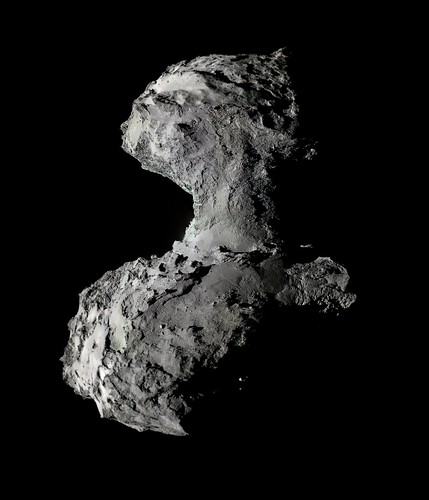 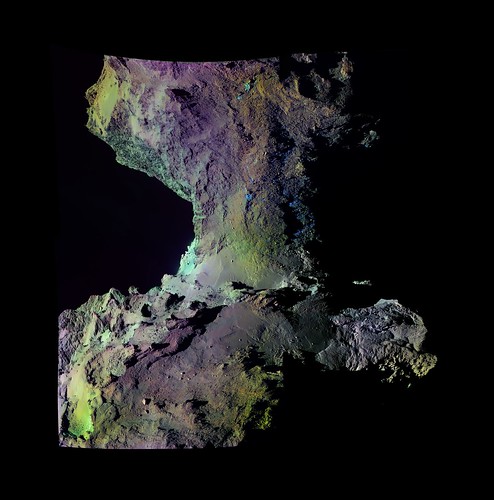 -------------------- |
|
|
|
 Dec 20 2015, 10:57 PM Dec 20 2015, 10:57 PM
Post
#22
|
|
|
Member    Group: Members Posts: 306 Joined: 4-October 14 Member No.: 7273 |
|
|
|
|
 Dec 21 2015, 05:43 PM Dec 21 2015, 05:43 PM
Post
#23
|
|
 Member    Group: Members Posts: 244 Joined: 2-March 15 Member No.: 7408 |
I looked for more moonlets in Herobrine's gif, this one jumped out at me on the right edge of the image. Edit: I see it now. Good eye! I kinda felt bad about not putting a little more effort into the animation given that it was so well-received and Emily even put it up on Planetary. The flickering background is really distracting to me, and it's like that because the program I wrote to spit it out used whatever the minimum value in the data was as the output zero point, and that changes from frame to frame. The maximum used was calculated in a more complex way, but also varied from frame to frame. Doing it per-frame was a bad idea and unnecessary since all 30 frames had the same filter (Empty_VIS610) and exposure time (10.2 seconds). So, I modified it to use 0 as the minimum (or something else constant; I can't remember; I tried it many different ways) and a constant maximum. I also rotated it 180 degrees like Emily did for Planetary. It looked a lot better, but I didn't ever post the improved version because I felt like it was beating a dead horse. However, since it seems some people have been looking for floaters/moonlets, I'll post this version which is much better for that. Tiny preview below. Click for full-size (2222x2049, 63 MiB) 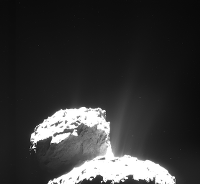 This version is built from the improved output (so no flickering background) and this time, the entire frames are included (no 1920x1080 crop) and they are all aligned1 to the background star field so stars don't move2, making it much easier to see anything floating around. The dimensions are 2222x2049 (instead of 2048x2048) because the frame position changes over time to keep the stars stationary. Empty regions at the sides, outside the bounds of a frame have been filled in with averages of other frames that did cover it. No bounce this time. At the end, it switches briefly to a frame that shows the positions, in every frame I could detect them, of 27 floaters/moonlets that I noticed in a search of the frames, overlaid on an average of all 30 frames, aligned to stars. Here's a little crop showing what it looks like. Notice the stationary star field and the track of the object that can be seen moving. 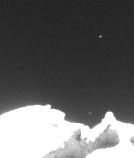 Click here for just the frame with the 27 tracks on it. 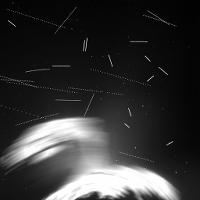 Each white pixel3 marks the detected position of an object in a single frame. Some of the objects are so faint that you may not be able to see them in the animation without adjusting the frame brightness/contrast. I found them by subtracting the average of all 30 frames (aligned to the star field) from each individual frame and then stacking the resulting frames in a "lighten only" way so that any moving object brighter than the background would appear as a series of dots. I checked the original frames to verify that each apparent trail was an actual object and to find the precise pixel to assign it for each frame. 1 - To the nearest pixel. I didn't want to damage the data by allowing it to be resampled/interpolated. 2 - Stars near the left and right side of the frame actually do drift very slowly by several pixels over the course of the 30 frames. 3 - Some positions are marked by two pixels where the object center (brightest point, really) fell near the boundary between pixels. |
|
|
|
 Dec 21 2015, 07:21 PM Dec 21 2015, 07:21 PM
Post
#24
|
|
 Member    Group: Members Posts: 404 Joined: 5-January 10 Member No.: 5161 |
Herobrine, that is awesome work! Amazing how many moonlets you teased out of the data. And thanks to all you other imagery wizards. Wish I had more time to participate...
|
|
|
|
 Dec 21 2015, 07:26 PM Dec 21 2015, 07:26 PM
Post
#25
|
|
|
Newbie  Group: Members Posts: 6 Joined: 17-November 14 Member No.: 7331 |
Some attempts
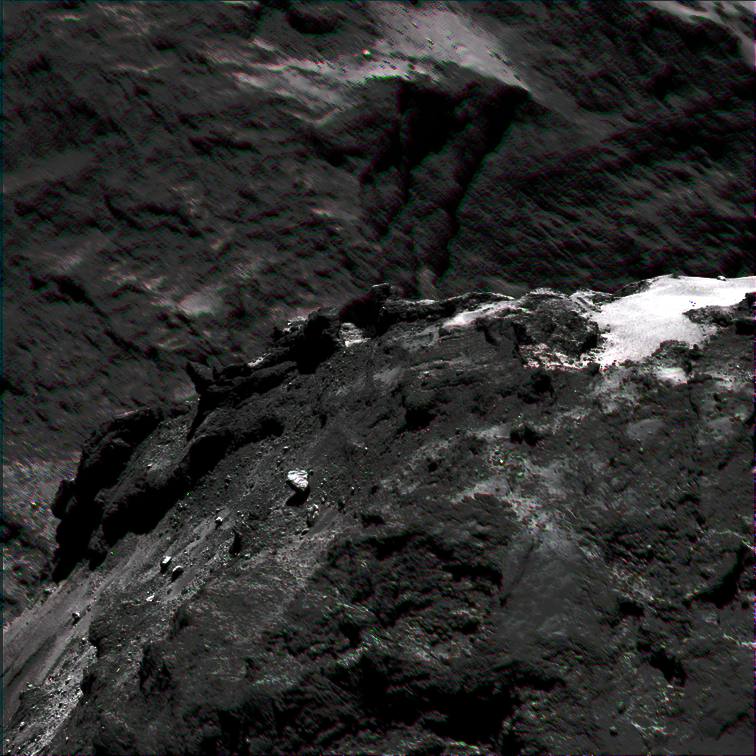 |
|
|
|
 Dec 22 2015, 09:35 AM Dec 22 2015, 09:35 AM
Post
#26
|
|
|
Member    Group: Members Posts: 306 Joined: 4-October 14 Member No.: 7273 |
Herobrine, I think you scooped up most of the floaters, there almost weren't any left for me to find!
I did manage to find a handful of other floaters. Most of them are very close to disappearing in sensor noise. I didn't go through and mark their positions in each frame, since they fade in and out of view, but I did mark their paths in yellow lines.  Full size here The one at bottom left very well could be a hot pixel, since it's moving pretty much horizontally and close to the same rate as frame movement. Otherwise I'm pretty sure the other ones are actual floaters. |
|
|
|
 Dec 22 2015, 12:26 PM Dec 22 2015, 12:26 PM
Post
#27
|
|
 Member    Group: Members Posts: 244 Joined: 2-March 15 Member No.: 7408 |
|
|
|
|
 Dec 22 2015, 04:30 PM Dec 22 2015, 04:30 PM
Post
#28
|
|
|
Senior Member     Group: Members Posts: 3009 Joined: 30-October 04 Member No.: 105 |
Herobrine-- in your third "stacked" non-animated image (http://www.unmannedspaceflight.com/uploads/post-7408-1450718176.png) I note that some of the dust-mote dotted trails have a kink or a bend in them. Is this actually happening, or is this an artifact of the imaging or processing? I also noticed this happening with some of the long-exposuer NavCam images. In some ways, they look/act like subatomic particles in a bubble chamber...
--Bill -------------------- |
|
|
|
 Dec 22 2015, 06:17 PM Dec 22 2015, 06:17 PM
Post
#29
|
|
 Member    Group: Members Posts: 244 Joined: 2-March 15 Member No.: 7408 |
Herobrine-- in your third "stacked" non-animated image (http://www.unmannedspaceflight.com/uploads/post-7408-1450718176.png) I note that some of the dust-mote dotted trails have a kink or a bend in them. Is this actually happening, or is this an artifact of the imaging or processing? I don't immediately notice a kink or bend in any of the trails. Some of them are a little jittery because one pixel in any direction is enough difference to make it look that way. I've added numbers for the trails here. Some (#13, for example) are a little curved, I'd guess because their orbital plane is nearly parallel to the image plane. Can you tell me the number of one of the kinked/bent ones? |
|
|
|
 Dec 23 2015, 11:49 PM Dec 23 2015, 11:49 PM
Post
#30
|
|
 IMG to PNG GOD     Group: Moderator Posts: 2256 Joined: 19-February 04 From: Near fire and ice Member No.: 38 |
|
|
|
|
  |

|
Lo-Fi Version | Time is now: 31st October 2024 - 11:26 PM |
|
RULES AND GUIDELINES Please read the Forum Rules and Guidelines before posting. IMAGE COPYRIGHT |
OPINIONS AND MODERATION Opinions expressed on UnmannedSpaceflight.com are those of the individual posters and do not necessarily reflect the opinions of UnmannedSpaceflight.com or The Planetary Society. The all-volunteer UnmannedSpaceflight.com moderation team is wholly independent of The Planetary Society. The Planetary Society has no influence over decisions made by the UnmannedSpaceflight.com moderators. |
SUPPORT THE FORUM Unmannedspaceflight.com is funded by the Planetary Society. Please consider supporting our work and many other projects by donating to the Society or becoming a member. |

|